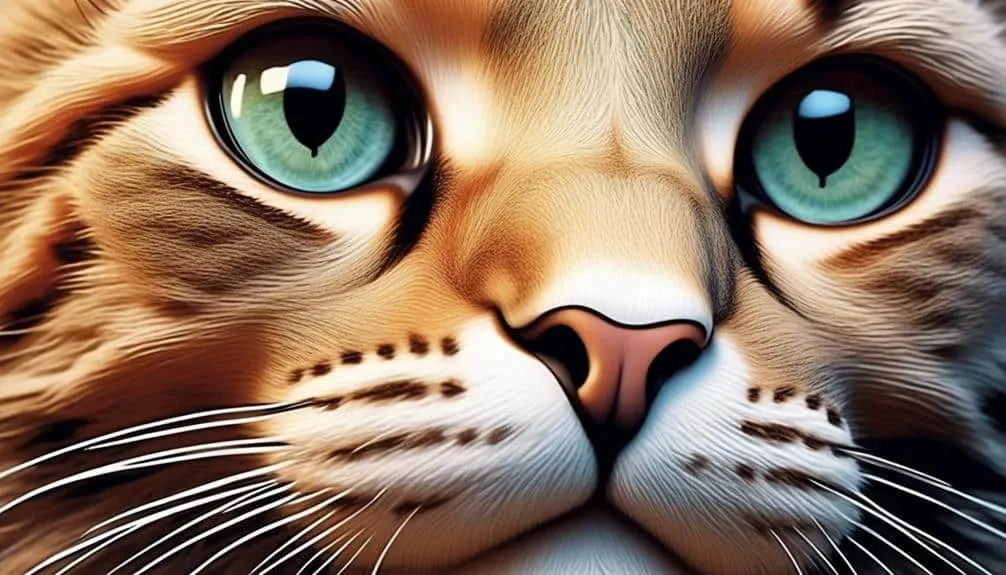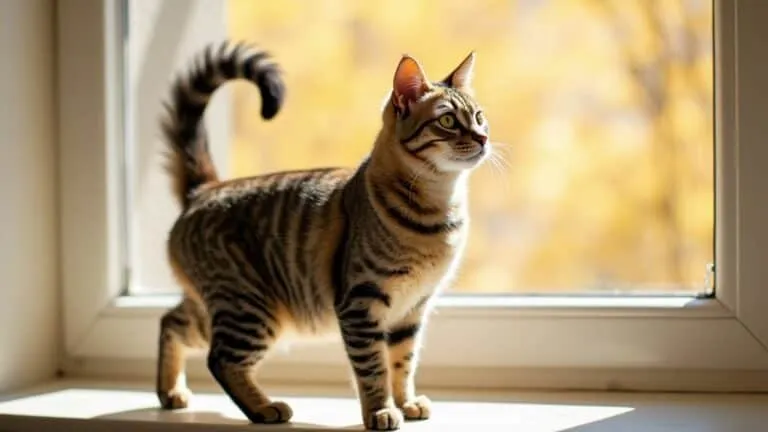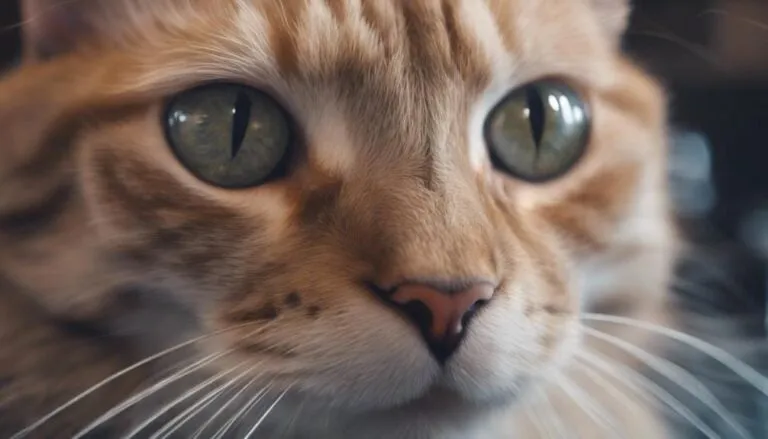The Best Fluffy Pancakes recipe you will fall in love with. Full of tips and tricks to help you make the best pancakes.

Have you ever noticed how your cat’s nose seems to be constantly at work, sniffing everything in sight? It’s fascinating to think about the incredible sense of smell that cats possess and the role it plays in their daily lives.
As we go about our day, we might not give much thought to the scents around us, but for cats, it’s a whole different story. In fact, their sniffing behavior reveals a hidden world of communication, social interaction, and survival instincts that is both intriguing and captivating.
So, let’s dive into this captivating subject and uncover the secrets behind cats’ fascinating sniffing behavior.
Key Takeaways
- Cats have a superior sense of smell compared to humans, with 45 to 80 million olfactory receptors.
- Sniffing faces is a greeting gesture and helps cats build familiarity and trust with their owners.
- Communication through scent is an important aspect of cats’ social behavior, marking territory, and bonding with other cats.
- Scent plays a crucial role in how cats navigate their environment, recognize their tribe, and identify predators, prey, and spoiled food.
Reasons for Cat Sniffing
Cats engage in sniffing behavior for a variety of reasons, which are rooted in their superior sense of smell and their need to communicate and navigate their environment. Cat sniffing behavior is driven by curiosity and the importance of scent for cats.
Through sniffing, cats gather information about their surroundings, identify familiar and unfamiliar objects, and communicate with other cats. Sniffing allows cats to gather information about potential prey, predators, and even spoiled food. Additionally, cats use scent to mark their territory and establish familiarity.
By sniffing their owners, cats create a bond and recognize their human companions. The curiosity-driven sniffing behavior of cats showcases their incredible olfactory abilities and highlights the significance of scent in their lives.
Understanding and appreciating this behavior can help us better serve our feline friends.
Feline Sense of Smell
The feline sense of smell is a remarkable and intricate sensory system that plays a crucial role in cats’ perception and understanding of the world. Understanding feline olfactory abilities and the impact of scent on cat behavior is essential for serving our feline friends. Here are three key aspects to consider:
- Superior olfactory receptors: Cats possess 45 to 80 million olfactory receptors, far surpassing our own capabilities. This heightened sense of smell allows them to detect a wide range of scents and navigate their environment effectively.
- Communication through scent: Scent plays a vital role in cats’ social interactions. Through scent glands and pheromones, cats convey information about their behavior, mark their territory, and establish familiarity and bonding with other cats.
- Behavioral influence: Scent has a significant impact on cat behavior. It helps cats recognize their tribe, identify predators or prey, and even recognize their owners. Changes in scent can affect a cat’s curiosity and behavior.
Understanding the feline sense of smell provides valuable insights into their world and enables us to better understand and care for our feline companions.
Communication Through Scent
Communication through scent is a fundamental aspect of feline social behavior and plays a crucial role in their interactions with the world. Cats use scent glands to release pheromones, which are chemical signals that provide information about their social behavior. These pheromones help cats mark their territory and identify others. Scent creates familiarity and helps cats bond with each other.
It’s through scent that cats see and interact with the world around them. Scent is also essential for cats to recognize their tribe, detect predators and prey, and even recognize their owners. Changes in scent can significantly affect a cat’s behavior and curiosity.
The connection between scent and territorial behavior is evident in how cats use scent to mark their territory and establish boundaries with other cats. Overall, the role of pheromones in cat communication is vital, as it helps cats navigate their social environment and establish meaningful connections with others.
Importance of Scent for Cats
The interplay between scent and territorial behavior in cats reveals the essential role scent plays in their recognition of social boundaries and establishment of meaningful connections with others. Understanding the importance of scent for cats is crucial in comprehending their behavior and communication patterns.
Here are three key reasons why scent is vital for cats:
- Scent marking: Cats use scent to mark their territory, leaving behind chemical signals that communicate their presence and ownership. This helps establish boundaries and avoid conflicts with other cats.
- Scent-based communication: Cats rely on scent to convey information about their social behavior, emotions, and reproductive status. Chemical signals released through scent glands provide valuable insights into their intentions and needs.
- Bonding and identification: Scent helps cats establish familiarity and trust with their owners, recognize their own kittens, and identify other cats in their social group. Changes in scent can significantly impact a cat’s behavior and curiosity.
The Flehmen Response
With their highly developed sense of smell, cats exhibit a fascinating behavior known as the Flehmen response. This behavior is characterized by the cat lifting its head, curling back its lips, and inhaling deeply through its mouth.
But why do cats exhibit the Flehmen response? The physiological mechanisms behind this behavior are intriguing. When a cat encounters an interesting scent, it often triggers the Flehmen response. This behavior allows the cat to transfer the scent molecules to the vomeronasal organ, also known as the Jacobson’s organ, located in the roof of its mouth.
The vomeronasal organ then analyzes the scent, providing the cat with additional information about the object or animal that produced the scent. In essence, the Flehmen response allows cats to gather more detailed olfactory information, enhancing their understanding of the world around them.
Cats’ Sensory Perception
Cats possess an intricate sensory perception that allows them to navigate and comprehend their environment with remarkable precision. Their sense of smell plays a crucial role in their behavior and social interactions.
- How cats’ sense of smell impacts their behavior:
- Cats use their sense of smell to recognize their tribe, detect predators, prey, and spoiled food, and identify their own kittens.
- Changes in scent can affect a cat’s behavior and curiosity, as they rely on scent to navigate and understand their surroundings.
- The role of scent in cats’ social interactions:
- Cats use scent glands and pheromones to communicate with other cats, mark territory, and bond with each other.
- Scent creates familiarity and helps cats recognize and trust each other, building social connections.
Cats’ sensory perception, particularly their sense of smell, is a vital component of how they perceive and interact with the world around them. Understanding and appreciating their sensory abilities can aid in providing them with a fulfilling and enriched environment.
Conclusion
Considering the crucial role of cats’ sensory perception, particularly their sense of smell, it becomes evident that understanding and appreciating these abilities is fundamental for comprehending their behavior and interactions with the world.
Like a symphony conductor, their sense of smell orchestrates their social interactions, helps them navigate the world, and keeps them safe.
The power of scent in cat communication can’t be understated. Cats rely heavily on their olfactory senses to navigate their environment, communicate with other cats, and bond with their owners. Their superior sense of smell, with 45 to 80 million olfactory receptors, allows them to detect a wide range of scents, including individual human scents.
Cats use scent glands to release pheromones, which provide valuable information about social behavior and help them mark territory. Scent is also essential for cats to recognize their tribe, detect predators and prey, and even recognize their own kittens.
Just as a key unlocks a door, scent unlocks a cat’s understanding of their surroundings and allows them to communicate with their fellow felines and humans.
The intricate world of scents is the invisible language that connects cats to their environment and to us, revealing the hidden depths of their sensory perception.








